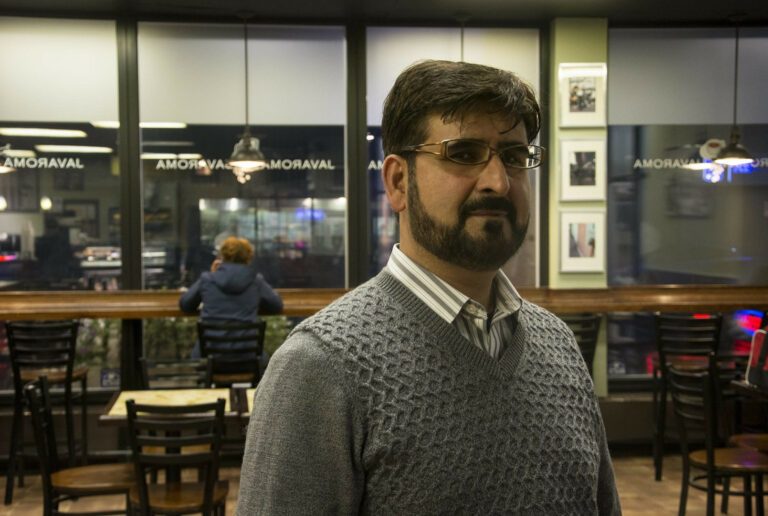by Herb Mathisen | photo illustration by Pat Kane
For a while I believed that Arctic Air, in one year, had managed to undo my entire life’s work. Honestly, I don’t know how I could have expected otherwise after seeing the show’s initial promos describing Yellowknife as Calgary v2.0, but when I sat down for the first episode, I got sucked in like geese to a turbine engine. The first scenes, I must confess, were some of the most thrilling television moments in my life.
When Yellowknife’s “prodigal son” Bobby Martin returns to town, strutting through the airport – our airport! – I sat there basking in the brilliant novelty of it all. “That’s the real airport!” I exclaimed to my girlfriend, as he walked out those terrible revolving doors. It didn’t matter to her that it was the actual airport, but it did to me. It was all too much.
To preface things, I should say that, as a Yellowknifer now living in Montreal, I basically do three things: breathe, occasionally eat and enthusiastically spread the YK gospel. I talk up the city’s virtues at parties, drop ever-tangential references whenever there’s at least a hint of relevance to something Yellowknife and basically brag about how the city-so-often overlooked, is like anywhere else in the world, just cooler.
Now the CBC will do the talking for me, I thought. Here was Yellowknife, finally out in the open for all of Canada to see. After our people and characters and landscapes get some shine, Canadians will realize that Yellowknife isn’t some slow-moving backwater, but a vibrant and exciting place. All my hard work would be validated.
But that mood abated when Bobby meets a conspicuous cowboy-hat-wearing associate, Ronnie Dearman – nothing screams greedy outsider like a cowboy hat. Outside the airport, Dearman references the city and points toward Long Lake, but then we see the YK skyline from somewhere near the Racquet Club. “Hey, you can’t see downtown from there!” I yelled reflexively. This innocuous shot told me this show would not be true to life. As I nostalgically soaked up the pretty shots of Old Town, my petty grievances piled up: “That isn’t Harley’s.” “That’s not an exploration camp – that’s Long Lake.”
While these early annoyances were small inconsistencies that only an insecure Yellowknifer like myself would care about, some oversights were less forgivable. After dropping off a fuel load, Krista, the airline owner’s pilot daughter, finds she has to bring cargo back from the camp or she won’t be paid. Krista hadn’t factored this into the return leg, meaning she likely won’t have enough fuel to get back to Norman Wells. She makes a snap decision to take the cargo anyways. The DC-3 predictably runs out of fuel (this aircraft’s second engine death in two episodes) and comes into Norman Wells “dead-stick.” Meanwhile, the co-pilot is pinned in the cabin by a tractor, jarred loose mid-flight. But since it’s TV, everyone is safe in the end.
Northern pilots are professionals, not mavericks, but the show reinforces this stereotypical recklessness, something I found off-putting following Yellowknife’s horrifying recent air tragedies. I certainly wouldn’t put my money down for an Arctic Air plane ticket with its stance on safety.
Hijackings and hitmen, bomb plots and manhunts followed. Interspersed amongst these hackneyed plotlines were shots of beautiful landscapes and cultural performances, but it felt like the show was veering towards exploitative. Plus, the oversaturation of government-sponsored ‘Spectacular NWT’ commercials seemed like the GNWT was all too eager to endorse the show’s version of the North, which compounded my frustration.
The thing is, YK’s actual story reservoir is so deep, with aviation providing such a vital link to communities across the north. Pilots are under constant pressure to perform and the internal politics involved in actually getting that seat, with meritocracy butting heads with nepotism, are subjects ripe for examination and exploration. Yet we don’t see this.
Arctic Air’s Yellowknife looked like Yellowknife on the surface, but was populated by caricatures of northern archetypes. Businessmen are not purely greedy and they must feel conflicted as they balance shareholder expectations with moral decency. And aboriginal and territorial politicians must weigh community and environmental concerns with economic opportunities while still living in the fishbowl North, where angry residents can tee off at their leaders in line at Extra Foods. But Arctic Air abandoned realistic drama – like a labouring mother needing a medevac from Deline to Yellowknife – for shark-jumping television drama, and I took offense to the implication that real northern stories just weren’t that interesting.
I don’t know what it’s like to be a parent (I never owned a Tamagotchi) but I imagine the protective instincts I feel for Yellowknife are somewhat similar and I kept watching, only so I could defend the city from what the show had been saying about it. I quit Arctic Air this season, though, after Bobby and Krista landed near a forest fire, quickly abandoned the plane and then barely shrugged after it blew up. Last week, from another room, I asked my girlfriend what was happening. “There’s a polar bear…” she said. “…in a building.”
I’ll admit that I’m too hard on Arctic Air and that I probably feel no different about it than east coasters do about Republic of Doyle or Albertans about Heartland. It’s like getting angry with Cheese Whiz for not being cheese. I realize it’s a TV drama – a fictionalized, easy-to-access story set in a fictional Yellowknife, and I doubt the show could have ever placated me. I don’t need anyone telling the world what Yellowknife is, because that’s my job. From now on, if I want to see people I know on CBC, I’ll just watch Northbeat.







